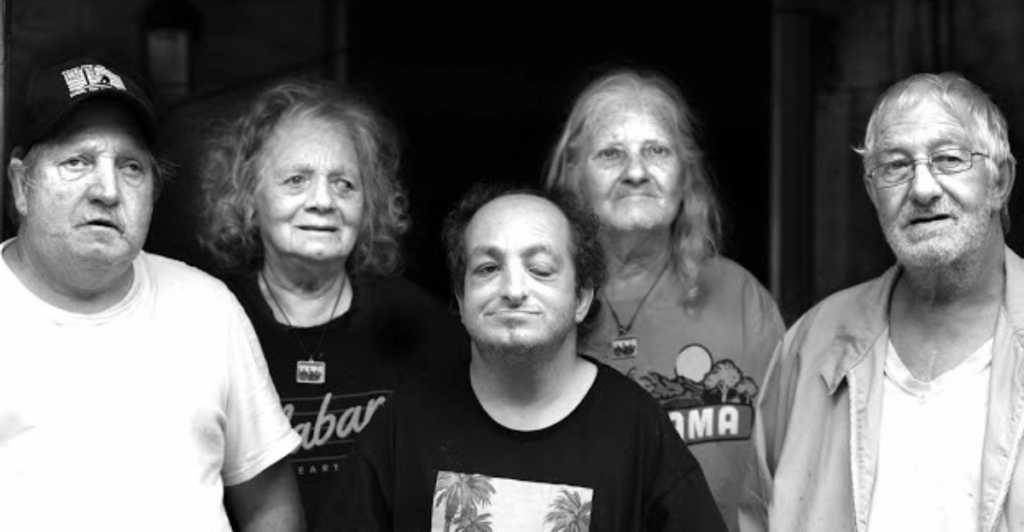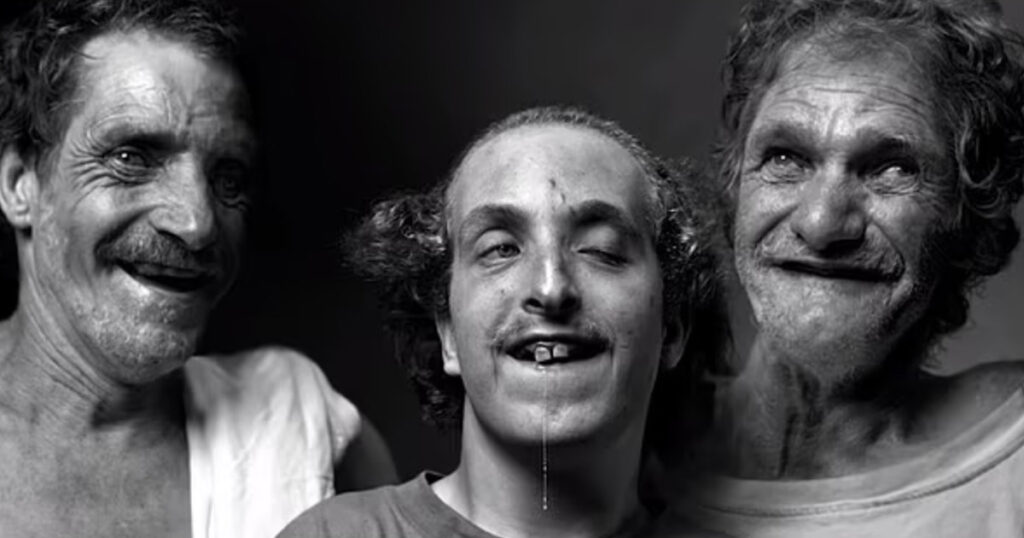Photographer Spent Years Helping America’s ‘Most Inbred Family’ Before They Faked a Death to Scam Him

Trust can take years to build and seconds to destroy. Mark Laita learned both lessons in a remote West Virginia town where one family’s desperate lie would test everything he thought he knew about loyalty, forgiveness, and human desperation.
For two decades, Laita documented the lives of the Whittakers, a family whose genetic history made them infamous across America. He dodged guns during first meetings. He weathered suspicion that came from years of abuse at the hands of cruel strangers. He donated money, brought groceries, and turned strangers into friends through patience most people don’t possess.
Then came the phone call in March 2024. A death. A funeral. A request for $1,000 that Laita sent without hesitation. Days later, the dead man walked out of a pickup truck, alive and confused about his own demise. Someone had lied. Someone had played him. And cameras captured every uncomfortable second of what happened next.
Meeting America’s Most Isolated Family
Odd, West Virginia sits 75 miles south of Charleston, a mountain community so small it barely registers on most maps. In 2004, photographer Mark Laita drove down winding roads to meet a family he’d heard whispers about for years. What he found would change his life and theirs forever.
First contact went badly. John’s brother met Laita with a gun. Suspicion ran deep in a family that had endured decades of cruelty from strangers. Locals had spent years terrorizing them for sport, treating their home like a target range for hatred.
Cousin John explained the years of abuse to Laita once trust began forming between them. “When I was growing up, people would come here and they would throw eggs at the house. They would throw stuff at the house and scream all hours of the night. I mean, people [were] just rude.”
Eggs splattered across windows. Taunts echoed through darkness. Strangers made their existence a spectacle, a cruel form of entertainment that left scars deeper than any physical wound could create.
Building Trust in a Small Mountain Town

Weeks turned into months. Laita kept returning without cameras, without demands. He brought groceries. He listened. Slowly, gun barrels lowered and doors opened wider.
By proving his intentions through patience rather than words, Laita earned something rare in Odd. Acceptance from a family that had every reason to reject outsiders forever. He started filming their daily lives, uploading content to his YouTube channel called Soft White Underbelly.
Millions of viewers watched as Laita showed how the Whittakers navigated their world. Betty handled shopping trips and medical appointments. Ray communicated through grunts and gestures. Lorene stayed quiet most days. Larry helped keep everyone together.
Videos racked up views, comments, and donations. People sent money. Some sent judgment. Either way, Laita had become part of their story whether he intended to or not.
A Daughter’s Desperate Cry for Help
March 2024 brought a phone call that shattered everything Laita thought he understood about his relationship with the family. BJ’s voice cracked with grief as tears poured through the phone line. Her father Larry had died. Heart attack. Gone at 67 years old.
She needed help with funeral costs. Could Laita spare anything to give Larry a proper burial? Without hesitation, he sent $1,000. After years of friendship, helping during tragedy seemed like the least he could do.
BJ thanked him through sobs. Laita uploaded a video announcing Larry’s death to his hundreds of thousands of subscribers. Comments flooded in with condolences. People who’d watched the family for years mourned a man they’d never met but felt they knew.
Everyone prepared for grief. Nobody prepared for what came next.
Larry Walks Out of His Own Funeral
Days after the supposed death, Laita drove back to Odd to film a memorial tribute. He wanted to capture stories from family members about Larry’s life. Betty and other siblings gathered on the front porch, ready to share memories.
A pickup truck rumbled up the dirt driveway. Larry stepped out, dressed in casual clothes, looking confused about why everyone seemed so shocked to see him. He was alive. Breathing. Walking around like someone who definitely had not suffered a fatal heart attack last week.
Laita stood frozen. Cameras kept rolling as the impossible unfolded before his eyes. Larry had just discovered his own death the night before while scrolling through YouTube videos. “No, I just heard of it last night on a video,” he told the photographer who’d paid for his funeral.
Years of trust collapsed in seconds. Someone had lied. Someone had taken money meant for a burial that never needed to happen. Someone had played Laita for a fool.
Confronting the Lie on Camera
BJ spotted Laita and bolted. She ran toward a trailer on the property, refusing to make eye contact. Laita called after her twice. She ignored both attempts and slammed the door behind her.
Twenty minutes passed before she emerged. Larry sat on the front porch beside Laita. BJ had no escape route left. Cameras captured every uncomfortable second as truth demanded its space in the conversation.
Laita played a recording of her original phone call. Her fake tears dripped through speakers. Her fabricated grief hung in the air between them. Larry shook his head in disbelief while listening to his daughter describe his nonexistent death.
Face to face on that porch, BJ finally admitted what she’d done. Addiction had driven her to desperate measures. She needed drug money and saw an opportunity to exploit someone who genuinely cared about her family. “I’m not proud of what I’ve done, I’m not. I shouldn’t have done it. I’m trying to get help for my drug addiction,” she confessed.
Shame covered her face. Regret colored every word. But apologies can’t erase lies that cut deep into relationships built over decades.
A Photographer’s Choice to Forgive
Laita faced a choice that many would struggle to make. Walk away from years of friendship over $1,000 and a betrayal? Or recognize that addiction turns good people into desperate liars?
He chose forgiveness. Not because the lie didn’t hurt. Not because the money didn’t matter. But because he’d spent enough time with the Whittakers to understand that survival in Odd looked different than survival anywhere else.
BJ wasn’t evil. She was sick. Drugs had corrupted her judgment the same way poverty corrupts options and desperation corrupts morality. Laita had documented enough hard lives to know that people in pain do painful things.
His continued involvement spoke louder than any angry words could. Some lessons teach through punishment. Others teach through grace extended when it’s least deserved.
Why Four Generations Married Within One Family
Understanding the Whittakers meant understanding how their family tree twisted back on itself for over a century. Twin brothers Henry and John Whittaker were born in 1897. Identical genetics marked them from birth.
Harry and Sally, cousins made even closer through their identical twin fathers, married and produced seven children. Among them was John Isom Whittaker, born in 1882. He fell in love with his first cousin Ada Rigg. Nine children followed.
Gracie Irene Whittaker entered the world in 1920 as one of those nine. When she reached marrying age, she chose her double cousin John Emory Whittaker in 1935. Double cousins share both sets of grandparents, making their genetic connection twice as strong as typical first cousins.
Gracie and John had 15 children together. Each birth carried genetic risks that compounded with every generation. Some babies died within weeks. Others grew into adults with severe disabilities that shaped every aspect of their existence.
Living with the Consequences of Inbreeding
Ray cannot speak words. Grunts and barks form his only language. He points and gestures like a child, communicating needs through sounds most people would struggle to interpret. Yet his family understands him perfectly.
Lorene stays silent most days. Her son Timmy came into the world after trauma no mother should endure. Rape by an unidentified attacker left her pregnant in 1979. She raised him anyway.
Several family members died young. Heart attacks claimed lives before middle age arrived. Genetic disabilities plagued multiple generations. Inbreeding carried consequences that medical science could predict but families in remote mountains couldn’t always avoid.
Geography, poverty, and isolation created conditions where marrying within families became normalized over decades. What began with twin brothers in 1897 echoed through chromosomes until 2024, when people with cameras arrived to document what resulted.
When a Mobile Home Went Up in Flames
Last year brought another crisis. Fire consumed their home, destroying what little the family owned. Smoke cleared to reveal loss that donations couldn’t fully repair.
Laita launched another GoFundMe campaign despite everything that happened with BJ. He raised $8,670 from strangers who wanted to help a family they’d only seen through screens. Money trickled in from people who believed everyone deserves shelter regardless of their past.
Even after being deceived about a fake funeral, Laita refused to abandon people who needed help. Some saw foolishness. He saw commitment.
A Filmmaker Who Won’t Walk Away

Years after that first gun greeting, Laita continues driving to Odd. He films. He donates. He maintains relationships that most people would have severed after one lie.
Betty still handles errands. Timmy still attends church services at Good Hope where Pastor William Plumley watches him sing with genuine joy. Neighbors still protect the family from gawkers who treat them like tourist attractions.
Laita sees beyond the lies, the disabilities, the complicated genetics. He sees people struggling with poverty, addiction, and circumstances they never chose. His camera captures lives that matter even when those lives make terrible choices.
YouTube brings them attention both wanted and unwanted. Money helps. Exposure hurts. But Laita keeps returning because walking away would prove every skeptic right. Staying proves something harder to quantify but easier to feel.
Some stories don’t end cleanly. Some families don’t fit neat narratives. Some photographers don’t give up on people just because people give them reasons to quit.
Loading...

